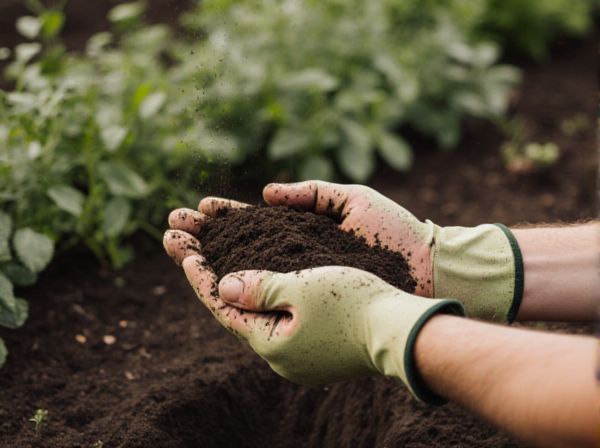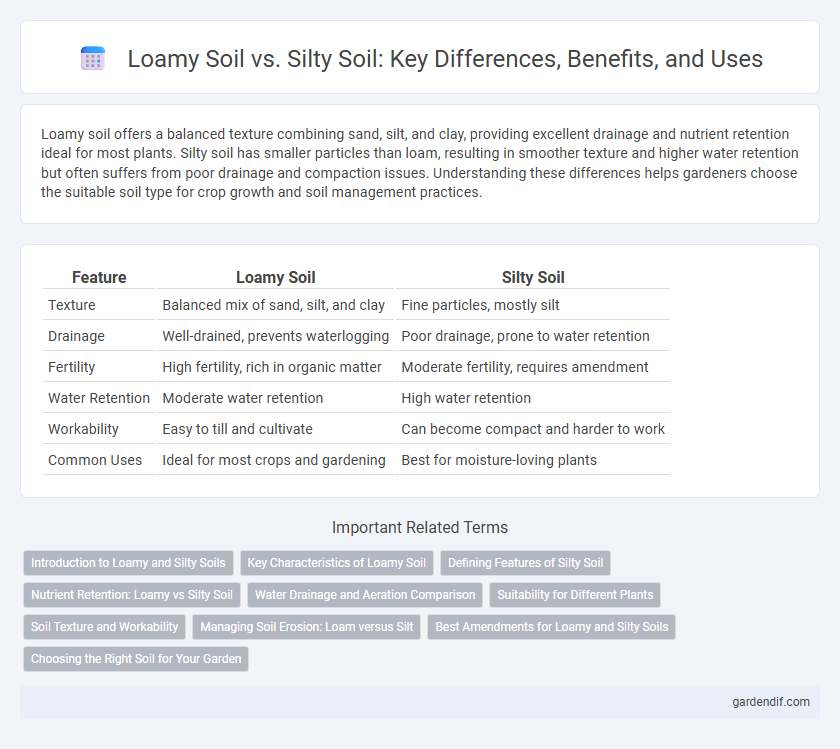
Loamy Soil vs Silty Soil Illustration
Loamy soil offers a balanced texture combining sand, silt, and clay, providing excellent drainage and nutrient retention ideal for most plants. Silty soil has smaller particles than loam, resulting in smoother texture and higher water retention but often suffers from poor drainage and compaction issues. Understanding these differences helps gardeners choose the suitable soil type for crop growth and soil management practices.
Table of Comparison
| Feature | Loamy Soil | Silty Soil |
|---|---|---|
| Texture | Balanced mix of sand, silt, and clay | Fine particles, mostly silt |
| Drainage | Well-drained, prevents waterlogging | Poor drainage, prone to water retention |
| Fertility | High fertility, rich in organic matter | Moderate fertility, requires amendment |
| Water Retention | Moderate water retention | High water retention |
| Workability | Easy to till and cultivate | Can become compact and harder to work |
| Common Uses | Ideal for most crops and gardening | Best for moisture-loving plants |
Introduction to Loamy and Silty Soils
Loamy soil consists of a balanced mixture of sand, silt, and clay, providing excellent drainage and nutrient retention ideal for plant growth. Silty soil is predominantly composed of fine particles that retain moisture well but can become compacted, affecting aeration and root penetration. Understanding the texture and composition differences between loamy and silty soils helps optimize soil management for agricultural and gardening purposes.
Key Characteristics of Loamy Soil
Loamy soil features a balanced mixture of sand, silt, and clay, providing excellent drainage and nutrient retention essential for plant growth. Its crumbly texture enhances aeration and root penetration, making it ideal for agriculture and gardening. Rich in organic matter, loamy soil supports microbial activity and sustains healthy soil ecosystems.
Defining Features of Silty Soil
Silty soil is characterized by its fine, smooth texture and high fertility due to abundant nutrients and good water retention capacity. It has smaller particles than sandy soil but larger than clay, allowing it to hold moisture well without becoming waterlogged. This soil type is ideal for agriculture as it promotes healthy root growth and provides excellent drainage compared to clay soils.
Nutrient Retention: Loamy vs Silty Soil
Loamy soil exhibits superior nutrient retention due to its balanced mixture of sand, silt, and clay, which enhances organic matter content and cation exchange capacity (CEC). Silty soil, while finer and smoother, tends to retain nutrients well but is more prone to compaction, reducing aeration and affecting nutrient availability. The optimal nutrient retention in loamy soil supports robust plant growth by sustaining essential minerals over time.
Water Drainage and Aeration Comparison
Loamy soil exhibits superior water drainage due to its balanced mix of sand, silt, and clay particles, preventing waterlogging while retaining adequate moisture for plants. Silty soil has finer particles that hold more water, resulting in slower drainage and increased risk of poor aeration. Consequently, loamy soil promotes better root oxygenation and overall plant health compared to silty soil's tendency to compact and restrict airflow.
Suitability for Different Plants
Loamy soil, composed of balanced sand, silt, and clay, offers excellent drainage and nutrient retention, making it ideal for vegetables, flowers, and most garden plants. Silty soil, with its finer particles, retains more moisture and nutrients but can become compacted, suiting moisture-loving plants like rice, lettuce, and brassicas. Choosing between loamy and silty soil depends on plant water needs and root aeration preferences.
Soil Texture and Workability
Loamy soil features a balanced texture with roughly 40% sand, 40% silt, and 20% clay, offering excellent workability and drainage. Silty soil contains finer particles than sandy soil, predominantly silt, which retains moisture well but can become compacted and harder to work with. The loamy soil's ideal texture facilitates root growth and aeration, while silty soil requires careful management to prevent poor aeration and drainage issues.
Managing Soil Erosion: Loam versus Silt
Loamy soil, with its balanced texture and higher organic matter, offers superior water retention and root support, reducing soil erosion more effectively than silty soil. Silty soil, while fertile, is more prone to compaction and surface crusting, which increases its susceptibility to erosion from wind and water runoff. Effective management practices like cover cropping and contour plowing enhance erosion control in both soil types, but loamy soil generally provides a more stable environment for erosion prevention.
Best Amendments for Loamy and Silty Soils
Loamy soil benefits from organic matter amendments like compost and well-rotted manure, which enhance its natural fertility and improve moisture retention without compromising drainage. Silty soil responds well to the addition of coarse sand or organic materials that increase aeration and prevent compaction, ensuring better root penetration and nutrient availability. Both soil types thrive with balanced pH adjustments, typically using lime for acidity or sulfur for alkalinity, tailored to specific crop requirements.
Choosing the Right Soil for Your Garden
Loamy soil offers an ideal balance of sand, silt, and clay, providing excellent drainage and nutrient retention essential for healthy plant growth. Silty soil, while rich in nutrients and moisture retention, tends to compact easily, which can hinder root development and water infiltration. Choosing the right soil depends on your garden's plant types and drainage needs, with loamy soil generally preferred for its versatility and fertility.
Loamy Soil vs Silty Soil Infographic

 gardendif.com
gardendif.com